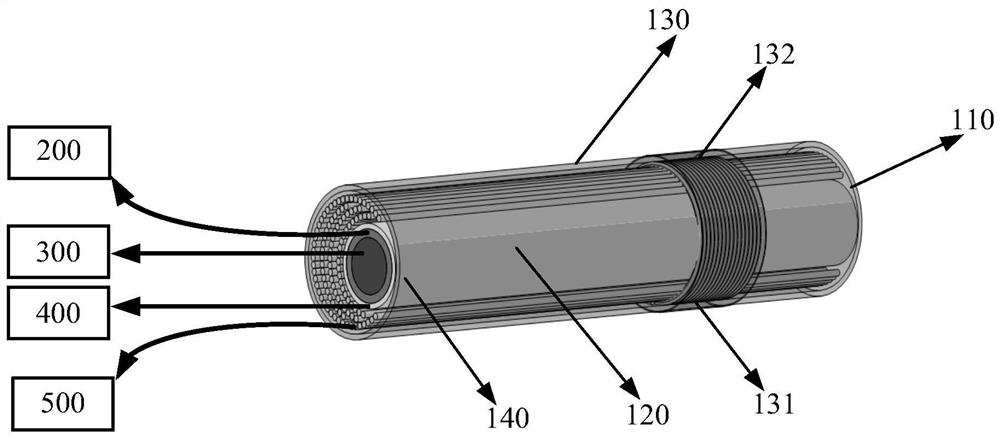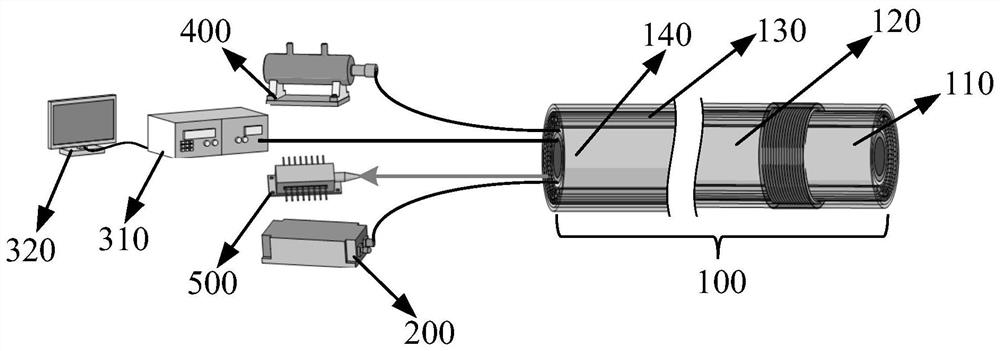Eccentric endoscope laser catheter
An eccentric, endoscopic technique, applied in the fields of endoscopy, catheterization, medical science, etc.
- Summary
- Abstract
- Description
- Claims
- Application Information
AI Technical Summary
Problems solved by technology
Method used
Image
Examples
specific Embodiment approach 1
[0025] The head end of the eccentric endoscope laser catheter tube (110) has three eccentric concentric circular apertures, the central aperture is used for the endoscope objective lens imaging system (112), and its aperture size is 1mm. In addition, there is an annular hole outside the central aperture for placing the illumination light source (113) required for endoscope imaging, and the size of the gap can be 0.3 mm. An annular aperture is designed on the outside of the aperture of the illumination light source for the discharge aperture (114) of physiological saline or gas, and the size of the gap is 0.2 mm. The injection of normal saline can reduce the damage of the lumen wall, or the injection of air can eliminate the interference of foreign bodies in the lumen, which is more helpful for imaging and treatment. Finally, the diameter of the whole catheter can be controlled in the range of 2.5-4.0mm, and can smoothly pass through the lumen in the human body for endoscopic i...
specific Embodiment approach 2
[0027] The optical fiber (111) for laser therapy used in the catheter can be a multi-wavelength optical fiber or a single-mode optical fiber. Flexibility for imaging and treatment within the vessel is maintained through the use of multiple small optical fibers. The fiber must be totally reflected in the core and the cladding. Considering that the core-to-cladding ratio of the fiber is 1:1.05 or 1:1.1, the core diameter of the small fiber can be controlled between 40-50 microns. In order to ensure the softness and flexibility of the conduit, the total number of optical fibers arranged in the entire conduit must not exceed 150, and the number of optical fibers can be controlled at 100-150 according to the size of the conduit. Adjust the number of optical fibers according to the specific clinical situation, and customize close-packed catheters, optimally spaced catheters, and high-density catheters. Tight-packed catheters consistently yield larger ablation areas, high-density ca...
specific Embodiment approach 3
[0029] Based on the first specific embodiment, the illumination light source (200) required by the endoscope system (300) for imaging is a cold light source. A cold light source is a light source that contains almost no infrared spectrum. The more popular light-emitting diode light source is a typical cold light source. The light generated by the cold light source is transmitted to the surface of the observed object in the lumen, and the surface of the observed object is illuminated. In order to make the illumination of the entire field of view uniform, the illumination range of the light source should be larger than the field of view angle, so the viewing angle of the light source part must increase the divergence function, and the light guide window of the light source can be made into a plano-concave lens.
PUM
 Login to View More
Login to View More Abstract
Description
Claims
Application Information
 Login to View More
Login to View More - R&D
- Intellectual Property
- Life Sciences
- Materials
- Tech Scout
- Unparalleled Data Quality
- Higher Quality Content
- 60% Fewer Hallucinations
Browse by: Latest US Patents, China's latest patents, Technical Efficacy Thesaurus, Application Domain, Technology Topic, Popular Technical Reports.
© 2025 PatSnap. All rights reserved.Legal|Privacy policy|Modern Slavery Act Transparency Statement|Sitemap|About US| Contact US: help@patsnap.com



